No roads and no tourists: A sparkling part of Australia few ever see
By Jim Darby
It’s still dark as we glide across Bramble Cove, outboard motor buzzing softly, the boat’s wake spreading over the windless water. We’re aiming at a small sandy beach with a frill of bush for a backdrop. There’s chatter aboard – this is no silent raid – we’re off to climb the mountain looming large above, and a perfect day for it is breaking.
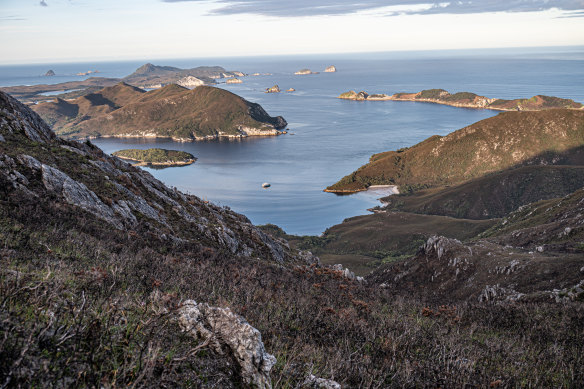
Luxury catamaran Odalisque III in Bramble Cove with the Breaksea Islands beyond. Credit: Peter Marmion
Out of the boat and boots on, we scramble through the scrub and then start the climb through open terrain. The tracks in these parts are mostly well-defined, but often rutted and sometimes overgrown.
Their free-range state is not surprising – the visitors here are few and the land to manage considerable. We’re in Tasmania’s Port Davey Marine Reserve, which is three times the size of Sydney Harbour and lies within Southwest National Park (618,000 hectares), which in turn is within the Tasmanian Wilderness World Heritage Area (1.6 million hectares).
That World Heritage wilderness is the massive lung of green you see when you look left on a map of Tasmania – no roads, just lakes and rivers, mountains and ridges, forests and native fields and an intriguing patch of blue that is Port Davey and Bathurst Harbour.
Home for thousands of years to the Indigenous Ninene and Needwonnee people, later the domain of piners and miners, Port Davey is now a refuge from the wild coast for cray and abalone fishers and host to a few rare visitors who come by air to the gravel strip at Melaleuca, or on foot as part of the 84-kilometre South Coast Track, or yachts or, like us, as part of a small cruise.
This is day four of our four-night/five-day cruise on the luxury catamaran Odalisque III. The mountain we’re aiming for is Stokes – no super summit at 428 metres, but we’re promised a view and it delivers.
The waterways are still and sparkling under the morning sun. The Port Davey reserve unfolds below, with its necklace of islands. The Southern Ocean is crashing away on the seaside, while the two or three yachts that are here hold calmly on the inside.
Look north and Frenchmans Cap is poking its peak into the distant sky, a little closer and the Western Arthur mountain range is marching across the landscape and closer still, down towards Melaleuca, the valley is capped by cloud.
Look south over Bramble Cove, past our catamaran at anchor, past the Breaksea Islands, and the next stop is Antarctica, or Patagonia if you take a right turn.
One of our hosts, Nancye Williams, shares cold cans of ginger beer she’s lugged up the track and the sugar hit is marvellous. We look over the way towards Spain Bay, our anchorage a couple of days ago for a walk to Stephens Bay, to find a wild Southern Ocean beach and remote Indigenous cultural site.
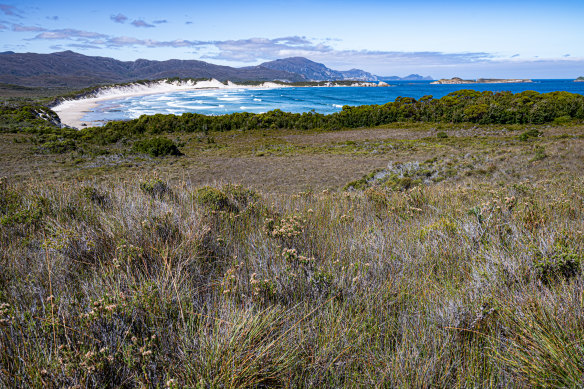
Stephens Bay and the Southern Ocean.Credit: Peter Marmion
For that walk, Odalisque’s tenders deliver us once again from the mothership to the beach and, as usual, it’s a wet landing – not much more than shin deep, but here’s the walker’s dilemma: how to get boots and socks back on without bringing a shoe full of sand along for the ride.
Problem solved – our hosts have a bag of towels just for this job. Overland we go, traversing a scrubby rise before we hit the beach, a long scallop of white. Most of the way along and almost as high as the dunes, we find an Indigenous dining area – thousands of shells, clams and cockles, abalone and native oysters, all bleached white by the sun and the salt. “The people are thought to have been here for at least 35,000 years,” our guide Peter Marmion says. “Never more than a few hundred at a time.”
That reflects the tough conditions – the wild weather of the south-west and the nutrient-poor soils. The population was in balance. As well as taking what they needed from the sea, they’d hunt on land and use firestick farming – burning the bush to flush out wallabies and encourage food to grow for them.
And that helps explain the landscape – vast fields of buttongrass and low scrub with patches of old Gondwana growth – Huon pines, dogwood, myrtle and sassafras – in the gullies which gather water and offer some shelter from the weather.
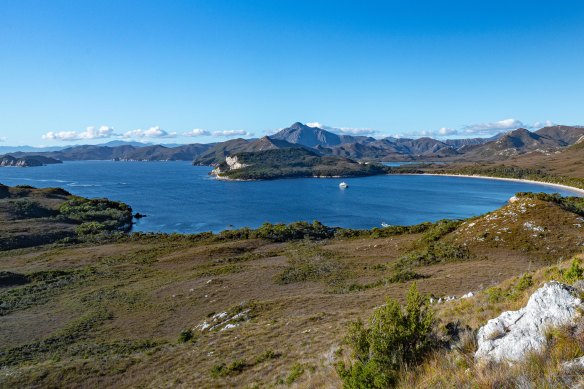
The bush and buttongrass fields above Spain Bay.Credit: Jimmy Emms
We stop for lunch just beyond the mounds, beside a creek of fresh water trickling its way into the bay. It isn’t hard to imagine life here before the Europeans – hunting, gathering and sheltering.
Back to day four and back off Mount Stokes for a quick swim, then to the yacht for breakfast and soon enough we’re in the tenders and following the shoreline of Bramble Cove, crayfish scuttling about below in the kelp, eucalypts grabbing a hold where they can on the rocky shore.
Then we head out towards the sea and nudge up against the very thing keeping us from it – the Breaksea Islands. Just like the name says, they shelter Port Davey from the massive swells of the Southern Ocean.
There are caves and caverns, tunnels from one side to the other, the swells moving inevitably through them. Shearwaters nest here in their thousands, gulls and little penguins call the islands home. Above us, a sea eagle is moving from tree to tree, all the better to keep an eye on us.
Back on the mainland, there’s a waterfall tumbling off a cliff face where some resourceful yachties have found a way to catch its water, funnelling it into a hose so they can tie up alongside and refill their freshwater tanks.
Our yacht, the 25-metre-long, eight-metre-wide Odalisque III, was purpose-built in Hobart to explore Port Davey and other parts of the Tasmanian coast. It’s as much luxury yacht as it is a nimble base camp.
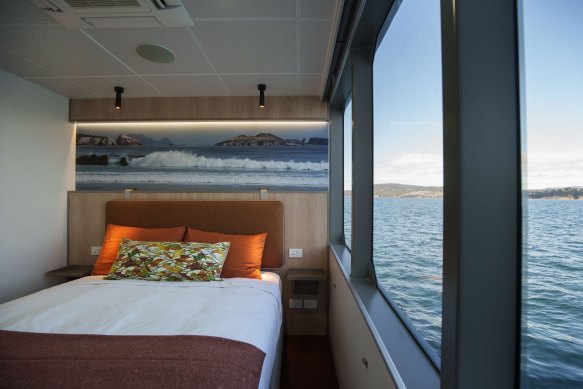
Inside a cabin on Odalisque III.
The cabins make clever use of the space allotted, each with a snug ensuite and, best of all, walls of glass to capture the views. There are two main lounge areas: on the main deck, where there’s also the dining area and a small library; and on the top deck, where you’ll also find the bridge.
Gone are the days of the big timber wheel to steer the ship. Skipper Matt Shepperd has a knob about the size of the volume control on a car radio to adjust our direction, and a bank of screens to show him water depth and traffic in the area (not much of the latter), but the bridge is still the place to be as we move from one anchorage to another.
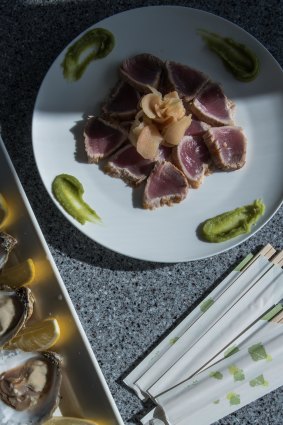
Angasi oysters and yellowfin tuna onboard.
There’s something of a roster of chefs – Tasmania doesn’t lack good ones – and we have Tom (“my mum calls me Thomas, but Tom’s fine”) Snowball in the kitchen. He has worked at Saffire and Van Bone, among others, and now grows food in the Huon Valley to supply restaurants. He’s an exceptional talent, using mostly fresh Tasmanian ingredients.
There’s so much of interest off the yacht, you forget the good times on it, the food and wine, relaxed but polished service, the ever-changing, always-engaging views and the chance to share it all with a small group of fellow travellers (11 guests and five crew on this cruise).
One of our first walks starts at Clayton’s Corner, named for Win and Clyde Clayton, cray fishers who set up house here last century. We come across a group of volunteers busily restoring their humble home, all happy to down tools and chat.
We make our way up the track and stop for a walker heading down. “Didn’t expect to see you here! How are you?” remarks our guide, Peter Marmion. It’s his brother Ian, once the ranger in charge of Tasmania’s Southwest. This place gets in your blood.
So much to see in five days. In bush caves, we see Indigenous petroglyphs (rock carvings) made so long ago we can only guess at their meaning. We spot animal tracks in the sand, of Tasmanian devils, wallabies and antechinus, and if a Tasmanian tiger were alive (the Claytons had regular visits from one in the 1950s), it would be here in the Southwest Wilderness.
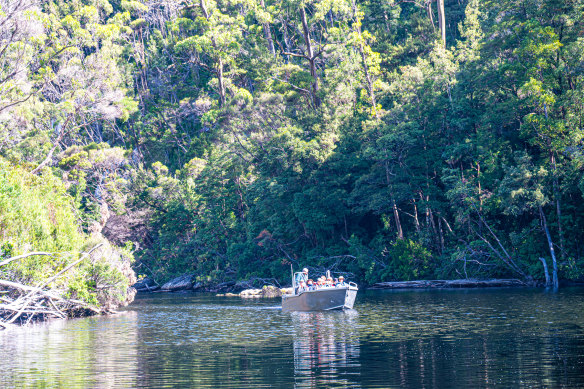
Exploring the Davey River Gorge.Credit: Peter Marmion
We explore the Davey River Gorge, Huon pine growing on its banks – the perfect timber for boats. Timber cutters (known as piners) once felled the trees way upstream, waited for the rains to bring it down and built ships here. We see birds you may never otherwise see – an azure kingfisher by the river, the endangered orange-bellied parrots at their summer home in Melaleuca.
Melaleuca is the closest thing to a settlement, a site where miners worked for tin and fell in love with this wilderness, people like Deny King, who raised a family here and even bulldozed the airstrip into existence. It was King who said, “Those who drink the buttongrass water always return.”
He was right about that. Of the few people we come across, all are repeat visitors, like the volunteers restoring huts and wooden boats or watching over the parrots. Our yacht’s crew are similarly hooked.
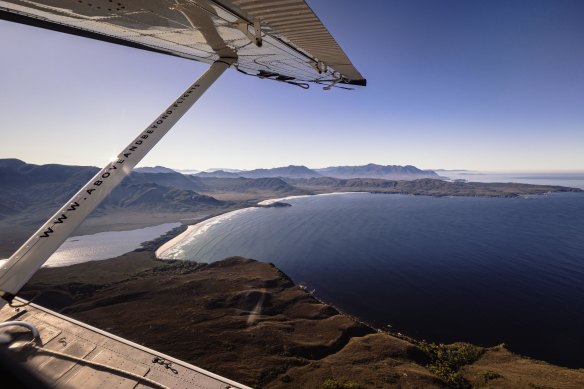
The view from the seaplane.
We eventually leave by the same means we arrive – airborne in a seaplane. On the way down, we met on the docks in downtown Hobart, then followed the coast – past Bruny Island, past Cockle Creek, road’s end for Australia, past Tasmania’s South East and South West capes, the wild Southern Ocean crashing into their cliffs. On our return, we fly over the mountain ranges and kunanyi/Mount Wellington, landing back on the water and motoring into Hobart’s docks.
Back to civilisation. But I drank the buttongrass water; now I just need to find a way back.
THE DETAILS
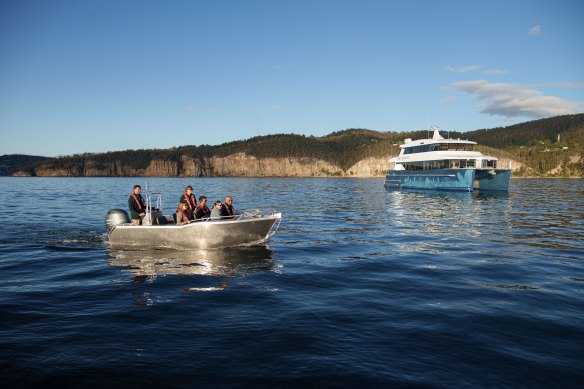
Odalisque III and one of her tenders.
On Board Expeditions offers all-inclusive four-night (from $11,600 a person) and six-night (from $15,400 a person) Port Davey Escapes. The season runs from December to May. They also have four-night East Coast Tasmania cruises (from $10,300 a person) at other times.
See onboardexpeditions.com.au
Jim Darby was a guest of On Board Expeditions.
Sign up for the Traveller Deals newsletter
Get exclusive travel deals delivered straight to your inbox. Sign up now.